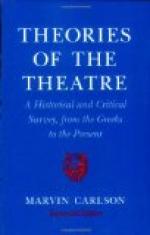But perhaps the most effective form of emphasis in the drama is emphasis by suspense. Wilkie Collins, who with all his faults as a critic of life remains the most skilful maker of plots in English fiction, used to say that the secret of holding the attention of one’s readers lay in the ability to do three things: “Make ’em laugh; make ’em weep; make ’em wait.” There is no use in making an audience wait, however, unless you first give them an inkling of what they are waiting for. The dramatist must play with his spectators as we play with a kitten when we trail a ball of yarn before its eyes, only to snatch it away just as the kitten leaps for it.
This method of emphasising by suspense gives force to what are known technically as the scenes a faire of a drama. A scene a faire—the phrase was devised by Francisque Sarcey—is a scene late in a play that is demanded absolutely by the previous progress of the plot. The audience knows that the scene must come sooner or later, and if the element of suspense be ably managed, is made to long for it some time before it comes. In Hamlet, for instance, the killing of the king by the hero is of course a scene a faire. The audience knows before the first act is over that such a scene is surely coming. When the king is caught praying in his closet and Hamlet stands over him with naked sword, the spectators think at last that the scene a faire has arrived; but Shakespeare “makes ’em wait” for two acts more, until the very ending of the play.
In comedy the commonest scenes a faire are love scenes that the audience anticipates and longs to see. Perhaps the young folks are frequently on the stage, but the desired scene is prevented by the presence of other characters. Only after many movements are the lovers left alone; and when at last the pretty moment comes, the audience glows with long-awaited enjoyment.
It is always dangerous for a dramatist to omit a scene a faire,—to raise in the minds of his audience an expectation that is never satisfied. Sheridan did this in The School for Scandal when he failed to introduce a love scene between Charles and Maria, and Mr. Jones did it in Whitewashing Julia when he made the audience expect throughout the play a revelation of the truth about the puff-box and then left them disappointed in the end. But these cases are exceptional. In general it may be said that an unsatisfied suspense is no suspense at all.
One of the most effective instances of suspense in the modern drama is offered in the opening of John Gabriel Borkman, one of Ibsen’s later plays. Many years before the drama opens, the hero has been sent to jail for misusing the funds of a bank of which he was director. After five years of imprisonment, he has been released, eight years before the opening of the play. During these eight years, he has lived alone in the great gallery of his house, never




